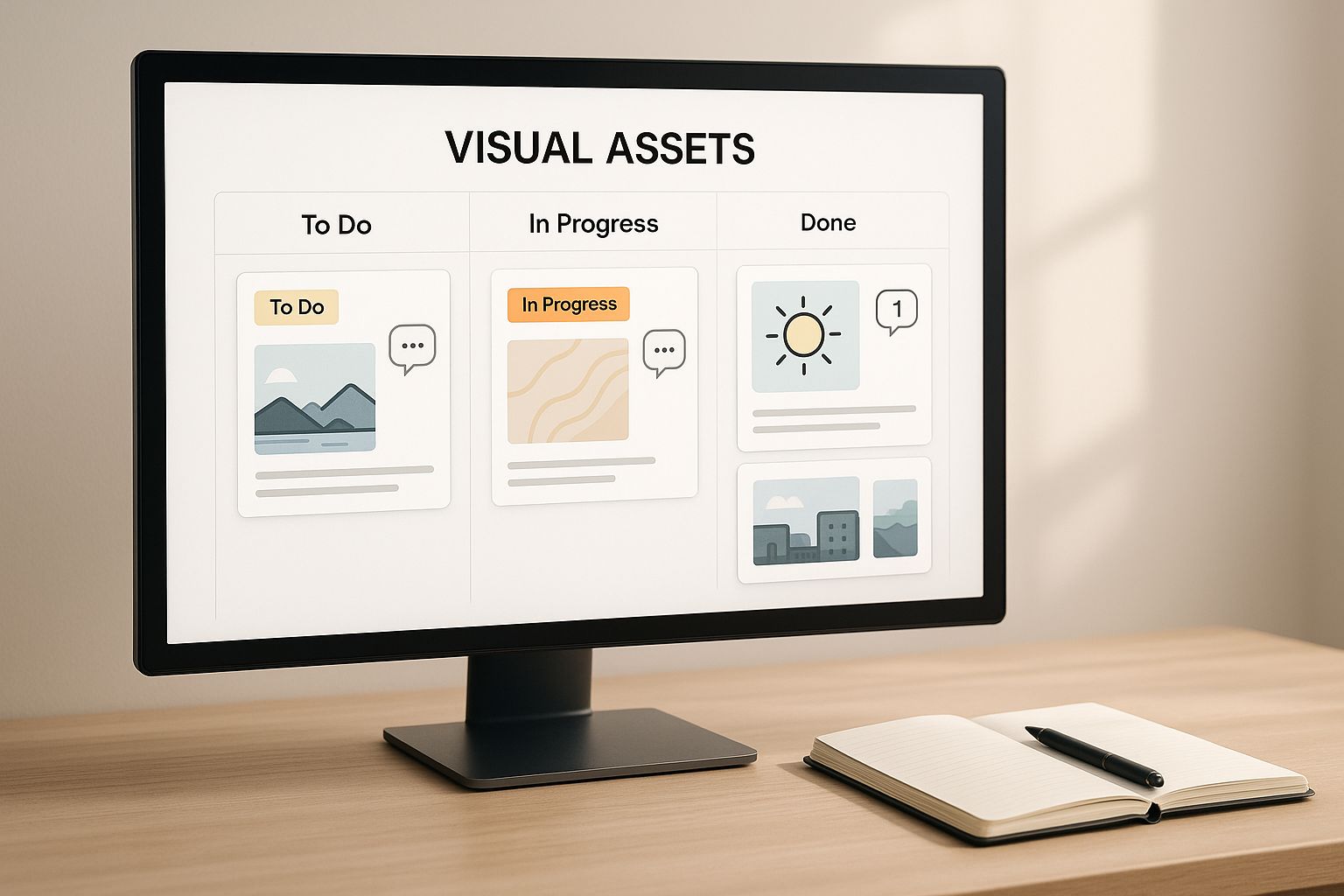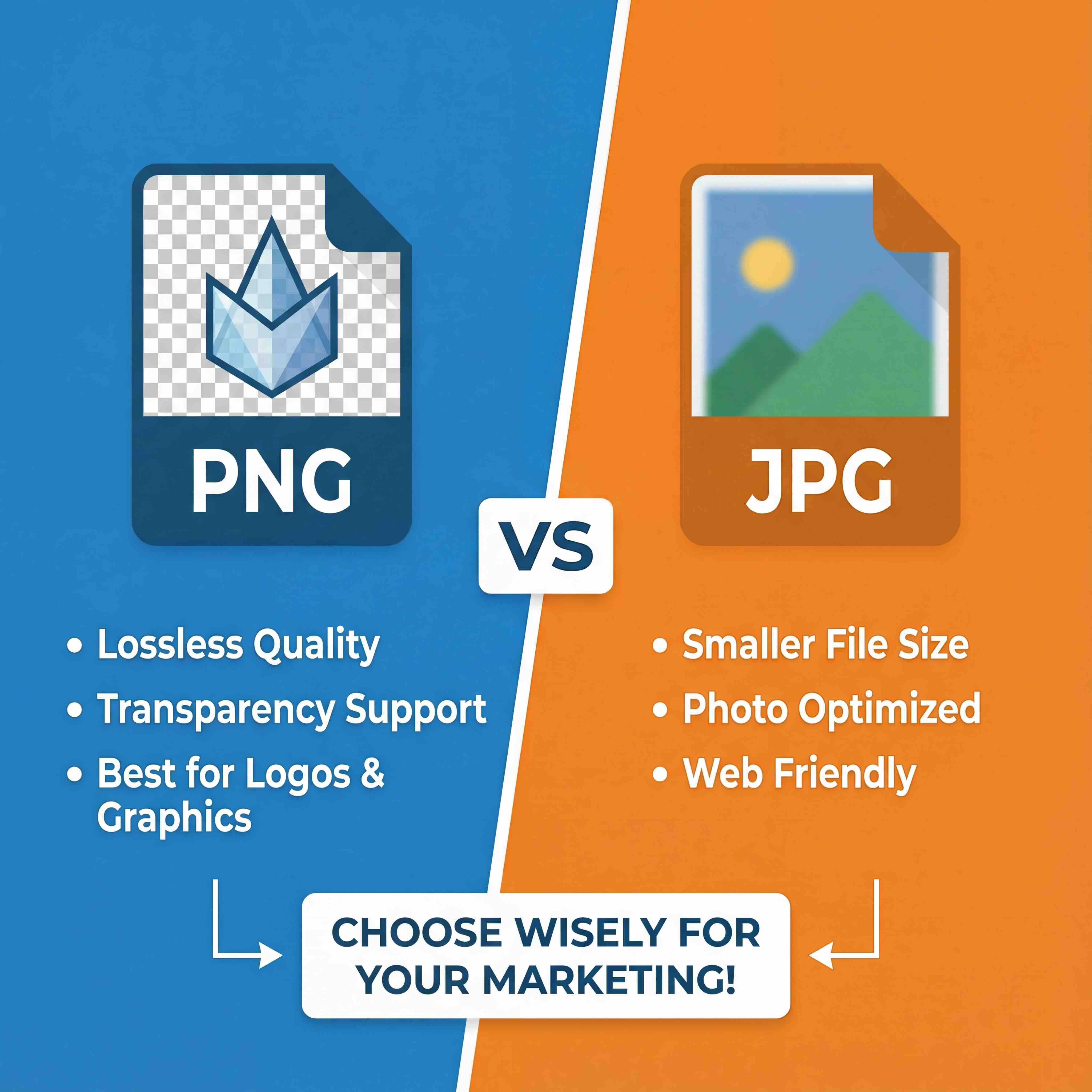Using a generic project management tool for a creative agency is like trying to produce high-fidelity visual assets with a spreadsheet. While you might be able to create colored boxes, the process is clumsy, inefficient, and guarantees a result that falls short of professional standards.
For today's agencies, specialized project management software for creative agencies isn’t a luxury; it's the core engine for scaling operations, maintaining profitability, and delivering exceptional visual work within a secure, enterprise-ready framework.
Why Generic PM Tools Fail Creative Agencies
Creative work is non-linear. It’s a dynamic mix of structured tasks, iterative development, and subjective feedback loops. A standard PM tool, built for predictable IT or manufacturing projects, cannot accommodate this complexity. It imposes a rigid structure on a process that demands flexibility.
This mismatch forces your team into inefficient workarounds, leading to fragmented email chains for feedback, unsecured Dropbox links for asset versions, and a patchwork of applications to keep a project moving. This disorganization not only wastes valuable time but also introduces significant security vulnerabilities when sensitive client assets are inadequately managed.

The Disconnect with Visual Collaboration
The most significant issue is that generic PM tools treat visual assets—the core of your agency's output—as simple file attachments. They see a Photoshop file, a video edit, or a 3D model as just another item on a checklist.
In a creative agency, the project is the visual asset. The conversation, feedback, and approvals must occur directly on the work itself to be effective and secure.
This fundamental disconnect creates a cascade of problems that specialized software is designed to solve:
- Fragmented Feedback Loops: Without integrated proofing tools, feedback arrives via disparate channels like Slack messages, annotated screenshots, and lengthy emails. It becomes exceedingly difficult to track revisions and ensure all stakeholder input is properly addressed.
- Lack of Formal Version Control: Generic tools offer no reliable method for managing multiple iterations. This leads to designers working from outdated files, final versions being accidentally overwritten, and hours of costly rework.
- Inability to Manage Creative Resources: A standard tool cannot differentiate between a copywriter and a 3D artist. It cannot assist in managing talent based on specific skill sets, capacity, or utilization rates, leading to inefficient resource allocation.
The Cost of Inefficiency and Risk
Ultimately, using inadequate tools has direct financial and reputational consequences. Inefficient workflows consume a significant portion of an agency's billable hours, directly impacting the bottom line. Every minute your team spends searching for the correct file or deciphering ambiguous feedback is a minute that cannot be billed.
More importantly, this disorganization exposes your agency to compliance and security risks. When client feedback and proprietary visual designs are exchanged through unsecured emails, you risk data breaches and intellectual property theft. A dedicated platform provides a secure, centralized environment, demonstrating to clients that you are a responsible, enterprise-grade partner. For any modern creative agency, this level of security is non-negotiable.
Key Features of Project Management Software for Creative Agencies
Selecting the right project management software for your agency is not about finding the longest feature list. It’s about identifying a solution designed to address the visual-first, feedback-intensive challenges your team faces daily. The right platform is more than a task manager; it is an integral component of your creative process.
This represents a significant market shift. The agency management software market was valued at approximately $4.30 billion in 2024 and is projected to reach $6.53 billion by 2030. This growth is driven by the demand from agencies for more effective project handling and secure client communication.
Consider how a visually-driven Kanban board can serve as the central hub for an entire creative project. Each card represents not just a task, but the visual asset itself as it moves through its lifecycle.

With a single glance, a project manager can ascertain the precise status of every deliverable, from initial brief to final client sign-off, eliminating the need to search through spreadsheets or request manual updates.
Visually-Driven Task Boards
Generic task lists are insufficient for creative professionals. They treat a complex 3D model with the same priority as a simple administrative task, which is impractical. In a creative workflow, the task is the visual asset.
Therefore, leading tools feature task boards where each card displays a live preview of the work. You see a thumbnail of the design, video, or 3D render directly on the board. This allows team members to instantly identify their assignments without navigating complex folder structures, reducing confusion and preventing costly errors. It transforms a static list into a dynamic overview of the project's status.
Centralized and Secure Asset Libraries
Nothing undermines productivity more than disorganized assets. Version control issues, security vulnerabilities, and time wasted searching for files like "final_final_v4_approved.psd" are all symptoms of a flawed system. A non-negotiable feature for any professional agency tool is a centralized and secure asset library.
This is more than a simple cloud storage folder. It is an intelligent hub that provides:
- Robust Version Control: Automatically track every iteration of a visual asset. You can compare versions side-by-side or revert to an earlier one with a full audit trail, preventing data loss.
- Permission-Based Access: Control precisely who can view, edit, or download sensitive client assets. This is critical for protecting intellectual property and maintaining compliance. For further details, consult our guide on how to organize digital assets.
- Advanced Search and Tagging: Enable your team to locate the correct asset in seconds using metadata, custom tags, project names, or even AI-powered visual recognition.
By centralizing assets within your project management tool, you establish a single source of truth. This eliminates confusion and provides a clear, auditable trail for every creative decision—a requirement for enterprise-level client work.
Automated Approval Workflows
Project bottlenecks frequently occur when feedback and approvals are lost in email inboxes. Manually following up is an inefficient use of time and presents an unprofessional image. Modern PM software for agencies resolves this with automated approval workflows.
You can configure multi-step approval chains that automatically route an asset to the next reviewer—from the Art Director to the client—as soon as a stage is completed. The system provides complete transparency, showing exactly where an asset is in the approval process and who is responsible for the next action. This is particularly vital when managing the unique demands of website design project management, where feedback cycles can become highly complex.
Integrated Time Tracking and Budgeting
For any agency, time directly translates to revenue. Without the ability to accurately track hours against projects, profitability cannot be protected. A top-tier creative PM tool offers integrated time tracking, allowing designers to log hours directly against the specific visual tasks they are working on.
This data populates real-time dashboards, providing managers with an immediate and clear view of project budgets. You can see at a glance if a project is approaching its budget limit or if a particular phase is taking longer than allocated. This allows for proactive adjustments before profit margins are impacted.
Choosing the Right Software for Your Agency
Knowing which features are necessary is only the first step. The next is selecting the right platform. This decision is more than a feature comparison—it is a strategic investment that will shape your agency's efficiency, security posture, and future growth.
Consider it analogous to laying the foundation for a new facility. One would not begin construction without a detailed blueprint. A hasty decision here can lead to frustrated creative teams, security gaps, and the costly process of migrating to a new system in the future.
Start by Mapping Your Unique Workflows
Before scheduling any product demonstrations, it is essential to conduct an internal analysis. Every creative agency has its own distinct operational rhythm for transforming an idea into a final asset. Your first task is to document this process.
Map the journey of a project through your team, from the initial client brief to the final delivered visual. Identify who provides the first round of feedback and the precise steps for obtaining client sign-off. Answering these questions provides a clear set of criteria for evaluating potential tools.
The best project management software does not force your team into a predefined structure. It should feel like a natural extension of your existing processes, reducing friction rather than creating it. A tool that aligns with your team's creative methodology is one that will be adopted successfully.
This workflow map becomes your most critical evaluation document. It ensures you find a system that adapts to your agency's needs, not the other way around. For a closer look at platforms that excel at this, review our list of the best creative project management tools.
A Practical Four-Step Evaluation Plan
With your workflow map complete, you can begin evaluating software with a clear and objective framework. This process should be a hands-on, security-first assessment involving your entire team, not just a passive viewing of a sales presentation.
Here is a straightforward plan for making an informed, secure, and future-proof decision:
- Involve Creatives in Hands-On Demos: Your designers, artists, and editors will be the primary users of this tool. Their buy-in is essential. Select two or three leading contenders and arrange for your team to participate in demos where they can ask questions and test real-world scenarios from your workflow map.
- Verify Critical Tool Integrations: Modern visual creation relies on a connected ecosystem of applications. Ensure the software integrates seamlessly with your essential tools, such as Adobe Creative Cloud, Figma, and 3D modeling software. A poorly implemented integration that requires constant manual intervention is counterproductive.
- Scrutinize Security and Compliance Protocols: This is a key differentiator between professional and consumer-grade tools. Request security documentation from vendors. If you work with international clients, confirm their compliance with data privacy regulations like GDPR and CCPA. Look for essential features like two-factor authentication (2FA), end-to-end data encryption, and role-based access controls.
- Review Support SLAs and Onboarding: Even the most intuitive software can encounter issues. Inquire about the vendor’s Service Level Agreements (SLAs) for support response times. A powerful platform with inadequate support can become a significant liability. Also, ask about their onboarding process to ensure your team can become proficient quickly.
Prioritizing Scalability and Future Growth
Finally, consider your agency's long-term trajectory. The tool you select today must support the agency you aim to be in three to five years. Can it accommodate more users, larger projects, and a significantly larger library of visual assets without performance degradation?
A scalable solution grows with your business, saving you from the substantial disruption of a system migration just as your agency is gaining momentum. Following this structured evaluation process will help you select a platform that is not just a tool, but a secure foundation for your future success.
Integrating New Software Into Your Creative Workflow

Implementing a new platform in your agency is fundamentally a change management process. Success depends on user adoption and the seamless integration of the software into your established methods of creating visual content.
The objective is not merely to replace old tools but to cultivate a more focused, collaborative, and secure environment where your creative professionals can perform at their best. This requires a more strategic approach than simply distributing login credentials.
Build Templates for Core Creative Projects
One of the most effective ways to secure buy-in is to make the software immediately useful. Instead of presenting your team with a blank slate, develop project templates for the core visual services your agency provides.
This demonstrates the tool’s value from the outset. It provides a structured framework that aligns with their existing responsibilities.
Consider creating templates for your primary workflows:
- New Brand Identity Project: Map out every phase, from mood boards and logo concepts to the final style guide delivery, with pre-configured approval stages.
- Video Ad Campaign: Outline the entire production pipeline, including scriptwriting, storyboarding, asset gathering, editing reviews, and final renders.
- 3D Product Visualization: Establish a repeatable workflow with clear steps for modeling, texturing, lighting, rendering, and structured client feedback rounds.
By doing this, you significantly reduce the learning curve. Creatives can immediately engage with a familiar process rather than building one from scratch, positioning the new tool as a supportive asset rather than an administrative burden.
Overcoming Resistance by Highlighting Benefits
Creative professionals are often resistant to disruptions that impede their workflow. The key to overcoming this is to frame the new project management software for creative agencies as a solution to their most significant operational challenges, not as a top-down mandate.
Focus on the tangible benefits for your artists and designers. A well-designed tool should enhance, not obstruct, their process, helping with optimizing content creation workflows.
The conversation must shift from, "You are required to use this," to "This tool will restore more of your time for creative work." Demonstrate how it eliminates tedious administrative tasks, centralizes feedback, and protects their focus by reducing unnecessary meetings and disorganized email chains.
When your team recognizes that the software is designed to help them spend less time on administrative work and more time on their craft, adoption becomes a natural progression rather than a forced requirement. For a deeper analysis of this topic, refer to our guide on project management for designers.
Establish Clear Communication Protocols
The market for creative agency software is projected to reach $1.48 billion by 2026, growing at an annual rate of 11.2%. This growth reflects a clear understanding that these tools deliver results; 77% of high-performing teams use them to enhance collaboration.
To realize these benefits, you must establish clear communication protocols within the platform from the beginning. Define precisely how communication should be handled to finally eliminate scattered emails and informal Slack messages.
Set clear guidelines for key interactions:
- Asset Feedback: All comments and change requests must occur directly on the visual asset within the platform. No exceptions. This creates an unalterable record.
- Status Updates: The project board serves as the single source of truth for progress. This eliminates disruptive "checking in" messages.
- Client Reviews: All client feedback and approvals are managed through the software’s secure portal, creating an organized and auditable record for compliance.
This structure establishes a predictable rhythm for communication, ensuring every conversation is logged, contextual, and directly tied to the specific visual work.
Future-Proofing Your Agency with the Right Tech
Selecting project management software for your creative agency is a strategic decision that dictates operational efficiency, team collaboration, and the ability to scale your business sustainably.
The right platform is not merely a task tracker; it is the central nervous system for your entire creative operation.
This reflects a fundamental shift in how creative work is produced. The global market for this software was valued at approximately $3.5 billion in 2023 and is projected to reach $7.8 billion by 2032. This rapid growth clearly indicates that agencies are migrating from generic tools to specialized, cloud-based hubs designed for modern, often remote, creative teams. You can read the full research about this market expansion to understand these industry trends.
A Strategic Asset for Sustainable Growth
A tool built for visual work does more than organize projects. It creates a secure, centralized environment that protects sensitive client assets and your agency's intellectual property. This positions you as a more reliable, enterprise-ready partner and provides a solid foundation for growth.
By reducing administrative overhead, you free up your most valuable resource: your creative talent. When designers, 3D artists, and video editors spend less time searching for files or deciphering feedback chains, they can focus on their core competency—producing exceptional work that delivers results for your clients.
Ultimately, the goal is to adopt technology that unleashes creativity, not constrains it. The right software builds a resilient, efficient, and forward-thinking agency prepared for future challenges and opportunities.
Investing in a platform like Virtuall, which integrates AI-powered generation, asset management, and collaboration into a single, secure workspace, is an investment in that future. It provides your team with the tools to innovate securely and efficiently, setting your agency up for sustainable, long-term growth.
Frequently Asked Questions
Choosing the right project management software raises many important questions. Is the investment justified? Will my team adopt it? Is our client data secure? Obtaining clear answers is crucial for making a sound business decision. Let's address the most common inquiries.
Making the right choice means finding a platform that doesn't just track tasks but acts as a secure, central hub for your agency's most valuable work.
Can Our Small Agency Just Use a Generic PM Tool Instead?
While possible, the operational inefficiencies will become apparent quickly. Generic tools are adequate for basic task lists but are fundamentally unsuited for visual workflows. They lack essential features like built-in visual proofing for annotating designs, formal asset versioning to track creative iterations, and secure client portals for sharing work in a controlled manner.
Attempting to adapt a generic tool for creative work invariably leads to inefficient workarounds, a reliance on insecure email for feedback, and a lack of control over sensitive visual files. This disorganization costs billable hours and compromises project quality and security.
How Do We Get Our Creative Team to Adopt New Software?
Successful adoption hinges on demonstrating how the tool makes the creative team's work easier and more efficient. The most common mistake is imposing a tool without their input. Instead, involve them in the selection process so they can see firsthand how it solves their primary challenges, rather than viewing it as another administrative burden.
During rollout, focus training on the direct benefits: less time spent on administrative updates, no more searching for scattered feedback, and more uninterrupted time for creative work. Provide pre-built project templates for common visual projects, such as a "New Brand Identity" workflow, to make it immediately valuable.
True adoption occurs when your team perceives the software not as a top-down mandate, but as a tool that respects and enhances their creative process. It should give them back their time, not consume it.
What Security Features Are Non-Negotiable?
For an agency handling client intellectual property, enterprise-grade security is a baseline requirement, not an optional feature. You need granular control to protect sensitive data at every stage of the project lifecycle.
Focus on these three security pillars:
- Role-Based Access Control: This is critical. It ensures that team members, freelancers, and clients can only access the specific projects and files relevant to their roles, preventing unauthorized data exposure.
- Robust Data Encryption: Look for platforms that encrypt data both in transit (during upload/download) and at rest (when stored on servers), using industry-standard protocols.
- Compliance with Data Protection Regulations: If you serve international clients, your software vendor must be compliant with regulations such as GDPR or CCPA. This is a fundamental requirement for any serious business partner.
Additionally, features like two-factor authentication (2FA) and a guaranteed uptime Service Level Agreement (SLA) are essential for protecting your agency's reputation and your clients' most sensitive visual assets.
Ready to unify your creative production with a secure, AI-powered platform? Virtuall combines 3D, image, and video generation with asset management and collaboration in a single workspace. Move from concept to final asset faster than ever before. Discover Virtuall today.











